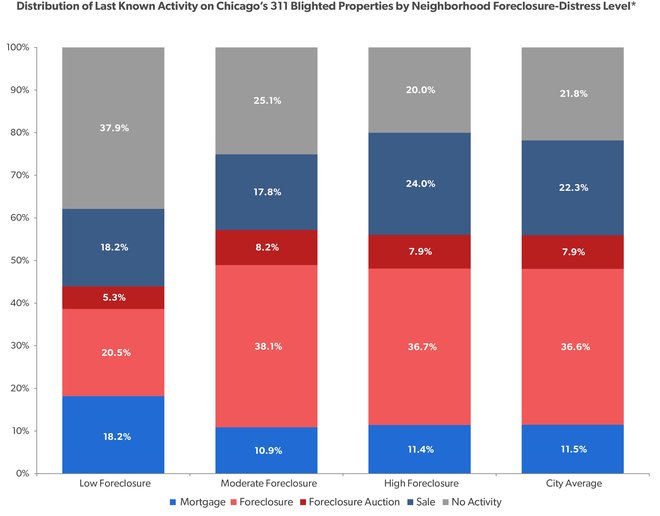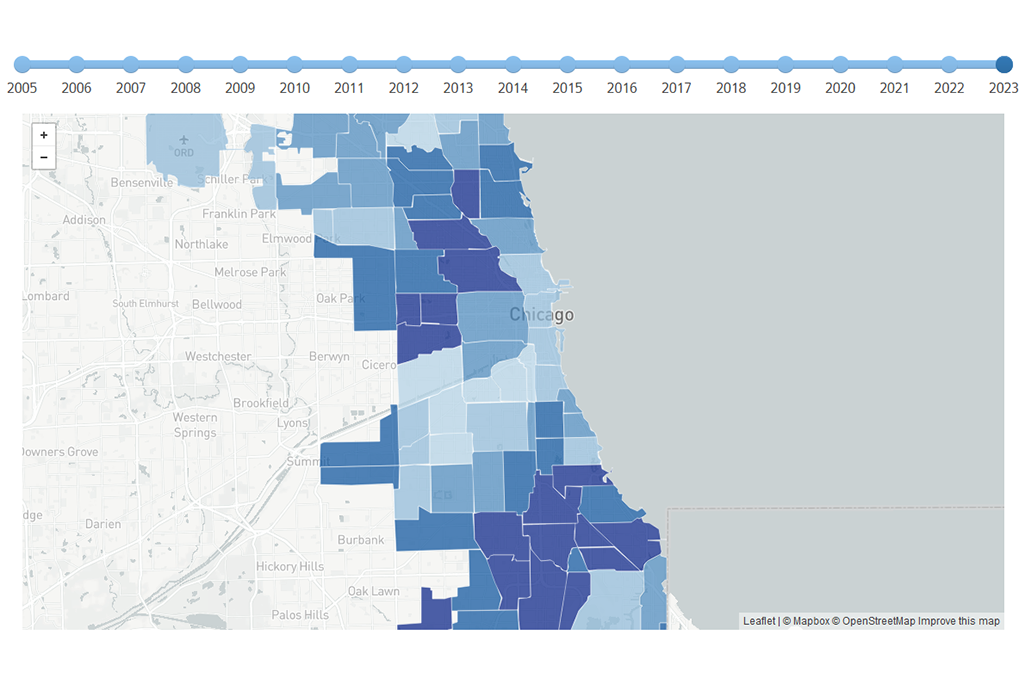Quality data and analysis are fundamental to the successful development and implementation of policy solutions to help solve the region’s vacant-buildings problem, but, in many cases, data gaps exist that make it difficult to answer key questions about property status and housing market conditions. IHS is working to utilize and expand its parcel-level Data Clearinghouse to help address these critical data and information gaps.
This blog post lays out a recent exploratory analysis IHS undertook that highlights some of these data challenges while also illustrating the potential that parcel-level analysis can have on shedding light on a vacant property’s status. The analysis below is based on a data set that creates a sequence of transaction activity preceding a likely vacancy. One key finding from this analysis identifies hundreds of vacant properties where the most recent transaction activity was a mortgage recording. In distressed neighborhoods, mortgages on these vacant properties were recorded, on average, over five years ago. Vacancy status and the lack of foreclosure activity on these properties raises concerns that these are buildings where both the borrower and the lender have chosen to walk away, leaving limited or no accountability for the property’s outcome.
Background
A recent Crain’s Chicago Business special report asked “Will the foreclosure crisis kill Chicago?” The report used data analyzed by IHS to illustrate the extent of the vacant property problem in the Chicago region and interviewed regional leaders about potential policy solutions. Aggregated data on long-term vacancy from the U.S. Postal Service and the U.S. Department of Housing and Urban Development used in the Crain’s report (available for Cook County on the IHS Housing Market Indicators Data Portal) can help policymakers understand broad trends and patterns of vacancy. However, the ability to implement policies that mitigate vacancy-associated blight at the neighborhood level require data on the precise location of an individual vacant property and an understanding of how that property came to be vacant. Although this has been identified as a key need, a comprehensive data set of parcel-level vacant buildings does not exist.
Building a Data Set to Understand the Status of Vacant Properties
Using our Data Clearinghouse, IHS has been developing a method to sequence different types of transaction activity on a property in order to better understand what events lead to certain negative outcomes such as vacancy. One potential use for this type of data could be to better identify how properties become vacant and distressed and know more about their current status. Analysis of the nature and sequence of a previous sale, mortgage, or foreclosure on a property prior to it becoming vacant and abandoned could help prioritize parcel-level risk factors that can lead to vacancy and make for more efficient intervention strategies.
We have been testing this sequencing method using 311 reports of vacant and/or open buildings available on the City of Chicago’s data portal as a proxy for distressed, vacant buildings. While 311 data is useful, it can only serve as a proxy of Chicago’s inventory of vacant and distressed buildings for a number of reasons. It only contains buildings that are reported by callers, and these reports are not necessarily verified by city agencies prior to posting on the City’s Data Portal. Additionally, properties are not removed from the 311 report data if they are demolished or reoccupied, so these data do not give a good sense of the existing inventory of vacant and abandoned buildings. Despite these limitations, 311 data are the best publicly available address-level data on vacancy.
IHS combined 311 report data from calls recorded between 2010 and September 2013 with data from the IHS Data Clearinghouse on property sales, mortgage activity, foreclosure filings, and completed foreclosure auctions from 2005 through the second quarter 2013. By ordering activity chronologically, it’s possible to determine the types of transactions occurring on a vacant property and the last known entity accountable for property outcomes.
 This shows an example of an activity sequence on one property in Humboldt Park. Looking back from the most recent 311 vacancy call in August 2013, we can see that the last known activity was a March 2009 property purchase out of Real Estate Owned or REO inventory for $30,000.
This shows an example of an activity sequence on one property in Humboldt Park. Looking back from the most recent 311 vacancy call in August 2013, we can see that the last known activity was a March 2009 property purchase out of Real Estate Owned or REO inventory for $30,000.
In one recent exploratory analysis, we tried to identify the current status of the most distressed vacant abandoned properties. In order to isolate the most distressed properties, we focused on buildings that had more than one 311 call reporting the property as open and/or vacant between 2010 and September 2013. In order to focus on properties most likely to be currently distressed, we looked at properties where the last 311 call was in 2012 or 2013 and where there has been no subsequent sale, mortgage, filing, or foreclosure auction on the property since the call was made. This process identified 20,660 properties with 311 vacant and or open calls. Of these, 4,489 properties fit the criteria where there were 1) multiple calls, 2) the most recent call was in 2012 or 2013, and 3) there was no subsequent activity. We refer to these 4,489 properties throughout this post as “311 blighted properties.”
What the Data Can Tell You
Where are the 311 blighted properties located?
Not surprisingly, the vast majority of the properties with multiple 311 calls regarding vacancy and without subsequent activity are concentrated on the City’s South and West sides – areas heavily hit by the foreclosure crisis. Overall, spatial patterns of 311 vacant building calls match patterns observed when mapping data on long-term vacancy from the USPS/HUD. Of the 4,489 311 blighted properties described above, 71.8 percent of them were located in heavily foreclosure-distressed areas. More than 25 percent of 311 blighted properties are located in just three Chicago Community Areas: West Englewood (11.5 percent), Englewood (7.4 percent), and Austin (6.4 percent).
What was the most recent type of transaction on a 311 blighted property?
Figure 1 below looks at the distribution of the most recent types of transaction for 311 blighted properties in different types of neighborhoods*. Citywide, the most common last known activity on these types of properties is a foreclosure filing. In the City of Chicago, 36.6 percent of all properties with multiple 311 vacancy calls and without any subsequent activity were properties where the last activity was a foreclosure filing on the property. For 22.3 percent of properties, the previous activity was a sale, 11.5 percent of properties’ last known activity was a mortgage, and for 7.9 percent, the last known activity was when the property entered real estate owned or REO status. For another 21.8 percent of 311 blighted properties, there has been no recorded activity since 2005 on the property. Figure 1 shows that the distribution of the last known activity is largely driven by patterns in moderate and high foreclosure neighborhoods. In low-foreclosure areas the pattern differs with much less of the activity being foreclosure-related.
 This chart shows the distribution of the last known activity on 311 blighted properties by neighborhood foreclosure-distress level*.
This chart shows the distribution of the last known activity on 311 blighted properties by neighborhood foreclosure-distress level*.
When was the most recent activity on 311 blighted properties?
Table 1 below shows the median number of years between the previous activity and the last 311 call for heavily foreclosure-distressed areas and for areas that have not been significantly impacted by foreclosure. The data show that, overall, properties with multiple 311 vacancy calls in distressed areas have had significantly longer lags between the last complaint and the last known activity. Whereas the median number of years between the last known activity and the last 311 vacancy call was 1.8 years in areas with low foreclosure levels between 2005 and 2012, properties with multiple 311 vacancy calls in highly foreclosure-distressed areas have had no activity in three years.
The lack of recent activity on a property can be indicative of many things, but, when paired with multiple vacancy calls and high levels of neighborhood distress, there are clear concerns about abandonment, blight, and a lack of control over the property. Table 1 highlights one clear manifestation of this concern. For 311 blighted properties in high- and moderate-foreclosure areas where the last activity was a mortgage recording, that mortgage recording took place, on average, more than five years before the most recent vacancy call. If we assume that these mortgages are no longer in repayment, the lack of subsequent foreclosure or sales activity points to the possibility of pre-foreclosure walkaway by both the owner and the mortgage servicer. For properties in this condition, it can often be difficult to identify an entity clearly accountable for the property’s outcome.
 This chart shows the average number of years between the last known activity and the 311 vacancy call by neighborhood foreclosure-distress level*.
This chart shows the average number of years between the last known activity and the 311 vacancy call by neighborhood foreclosure-distress level*.
How this Information Can be Applied
The analysis in this blog post was exploratory, but the types of information laid out above have a number of potential applications. As described above, in cases where a foreclosure filing or a mortgage was the last activity before the 311 vacancy call, the length of time between the last known activity can help determine whether the property is a potential pre-foreclosure or post-foreclosure walkaway. In other cases, if the last known activity was a sale, the owner is the accountable entity and it will be important to find out more information about ownership status.
What’s Next
In the coming months, we plan to continue to build this data set and conduct further analysis to help answer key policy questions about the region’s vacant-buildings problem. This includes looking for key information on the characteristics of sales and ownership associated with troubled properties and adding additional data to more accurately determine vacancy status as well as other outcome data, such as properties that have gone to building court or have been demolished.
Check back for future updates as we uncover more ways to use these data to better understand the nature of vacancy at the property-level. You can also look at our blog directory to find several other posts exploring patterns of vacancy and vacancy data. To be notified about new blog posts and to give us feedback, follow us on twitter, like us on Facebook, or join our LinkedIn Group.
* In low foreclosure areas, less than 10 percent of residential properties have had at least one foreclosure filing between 2005 and 2011; in moderate foreclosure areas between 10 and 24.9 percent of residential properties have had at least one foreclosure filing between 2005 and 2011; and for high foreclosure areas, 25 percent or more properties have had at least one foreclosure filing during this period.






